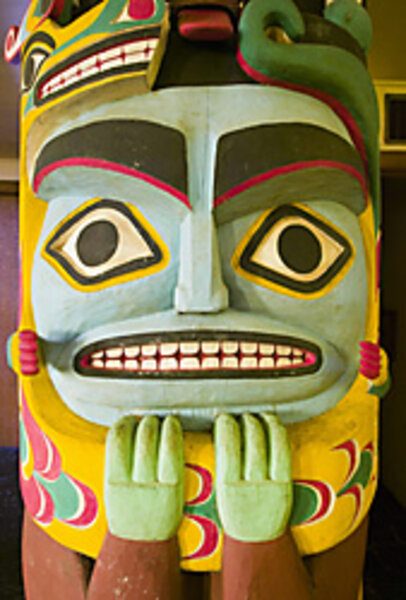A taste of history on the Grease Trail
Loading...
| Alert Bay, British Columbia
Recently, in my capacity as a chronicler of offbeat trips, I found myself off the coast of British Columbia, Canada, on Vancouver Island's so-called Grease Trail. Contrary to what you might think, this is not an itinerary that connects local Burger King, McDonald's, and KFC franchises. Rather, it's the route that Namgis First Nation people once used to transport grease across the northern part of the island.
A century ago, the grease in question – rendered from a small smeltlike fish called the eulachon – was at once a valuable trade item, a condiment, a medicine, and an insect repellent. Those First Nation people who didn't have access to it, like the Nuu-chah-nulth (formerly called Nootka), eagerly traded items such as copper and muskets with those who did, like the Namgis.
Eulachon grease is still esteemed by the Namgis, who refer to it as "liquid gold." At the instigation of Randy Bell, my Namgis host in Alert Bay, I smeared some on smoked salmon and instantly regretted it, for the grease replaced the inimitable flavor of the salmon with a flavor not unlike rancid lard.
Undeterred by my negative reaction, Randy offered to show me the highlights of the Grease Trail. So we climbed into his pickup truck, took the ferry to the town of Port McNeill, and then struck out for the island's interior.
Our first stop was a series of boulders on the shore of the Nimpkish River. Several frowning faces were carved onto them, an indication, Randy said, that enemy heads had once been lopped off at this site.
"Did the enemy make disparaging remarks about eulachon grease?" I asked uneasily.
"Not at all," Randy said. "The enemy were people from Gilford Island, and we always were fighting with them. We cut off their heads and hung them in that cedar tree above us."
Half expecting to see a collection of weather-worn human heads, I peered up at the tree. There was in fact one head, but it was attached to a bald eagle, a bird quite common in these parts.
A few miles south of Nimpkish Lake, we started hiking along a trail that grease-laden Namgis also would have hiked. Within minutes, the sky opened up, and what cascaded down from it would have made an Asiatic monsoon seem like a polite drizzle.
Randy, who seemed to be waterproof, cheerfully pointed out various items along the trail. Here was a "culturally modified tree" – i.e., a cedar that the Namgis had stripped of its bark. There was a bracket fungus that could be used either as a fire starter or a tea.
Once we returned to the truck, the rain, as if on cue, stopped. We followed a road that meandered along the shore of Woss Lake. A few years ago, Randy said, his truck had broken down not far from here, and he'd had to trek 25 miles in the middle of the night. Not that this would happen again, of course....
At one point he stopped and studied the lake. A strong wind was whipping it into a frenzy. "I'm afraid the boat portion of the trip is out," he said. "With this wind, we'd capsize."
"Well, I've already seen some very nice petroglyphs," I said, trying to conceal my disappointment.
As the rain started up again, we continued to drive south along the lake. The road grew more and more muddy. Toward the southern end of the lake, we came to a sudden halt: an avalanche blocked our way. For a moment, I thought that Randy might try to drive his truck over the mountainous clutter of rocks. But he didn't. We had no choice but to turn around.
The rain was now coming down even more heavily than before. I hoped that the truck would be equal to the task of getting us back to Port McNeill. Minutes later, however, I heard the telltale sound of a flat tire.
Randy began rummaging under the seat. "Someone seems to have taken my jack," he announced. Recalling the story of his 25-mile hike, I had visions of hiking back to civilization while being pummeled to jelly by the rain. Randy noticed the despairing look on my face. "Trust in serendipity," he told me.
"Where are you going?" I yelled after him – for he'd begun walking briskly down the road.
"To get help," he shouted back.
Meanwhile, the rain was beating a vigorous tattoo on the roof of the truck, sounding now like buckshot, now like machine-gun fire. I felt as if I was being attacked by a hitherto undocumented army of Vancouver Island guerrillas.
You can imagine my surprise when another pickup splattered up to Randy's half an hour later. Randy himself climbed out and flashed me the victory sign. Another man also got out and approached our vehicle with a jack. It wasn't long before the stricken tire had been replaced by a new one.
As we were driving back to Port McNeill, I said, "So how did you know you were going to find help?"
"I trusted in serendipity," Randy said. "Also, I'd seen my cousin's truck parked at the store in Woss, and since he's got a cabin down here, I figured he'd be coming this way."
Back in Alert Bay, Randy offered me more smoked salmon, on which I smeared more eulachon grease. This time the grease had a different, somewhat better flavor, as if it were somehow imbued with the primal elements that are such a dramatic presence in this part of the world.


